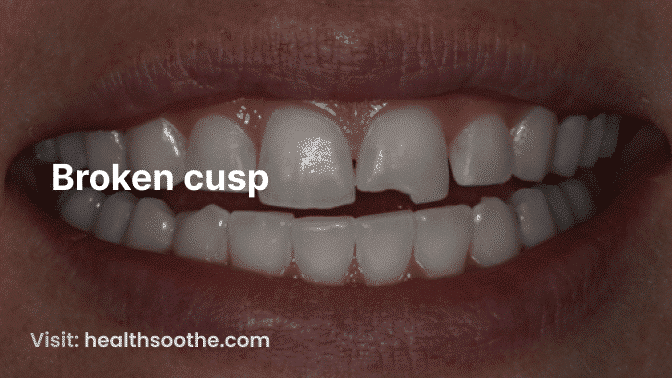Have you ever experienced a sharp pain while eating or drinking? Does it feel like something is stuck between your teeth or is there an odd sensation that is making it difficult to chew? If so, you may have a broken cusp. A broken cusp is a type of dental emergency that requires prompt attention to prevent further damage and pain.
What is a broken cusp?
A cusp is the pointed part of a tooth that helps to guide the food as we chew. A broken cusp is when the pointed part of the tooth is fractured or broken off, exposing the pulp inside the tooth, and leading to pain and sensitivity. Cusps are most commonly found on molars, which are the large teeth at the back of your mouth used for grinding food.
What causes a broken cusp?
A broken cusp can occur due to various reasons, such as:
- Biting down on hard objects like ice, hard candy, or pens
- Tooth decay
- Poor dental hygiene
- Grinding or clenching of teeth
- Trauma or injury to the mouth
Signs and symptoms of a broken cusp
The most common symptoms of a broken cusp include:
- Pain while biting or chewing food
- Sensitivity to hot or cold food and drinks
- Difficulty chewing food
- Swelling or inflammation around the affected area
- The rough or jagged edge of the tooth
Diagnosing a broken cusp
A dentist can diagnose a broken cusp by performing a dental exam and taking an X-ray to determine the extent of the damage. During the exam, your dentist may ask you about your symptoms and any recent dental procedures or injuries to the mouth.
Read Also: Dental ADA Codes 2023: Current Dental Terminology
Treatment options for a broken cusp
The treatment options for a broken cusp depend on the severity of the damage. In most cases, the dentist will recommend one of the following options:
- Dental filling: If the break is minor, a dental filling may be used to restore the tooth to its normal shape and function.
- Dental crown: If the damage is more extensive, a dental crown may be used to cover the tooth and protect it from further damage.
- Root canal: If the pulp inside the tooth is exposed or infected, a root canal may be necessary to remove the damaged pulp and prevent further infection.
- Tooth extraction: If the damage is severe, and the tooth cannot be saved, the dentist may recommend extracting the tooth.
Possible complications of a broken cusp is left untreated
If left untreated, a broken cusp can lead to various complications such as:
- Severe pain and sensitivity
- Tooth decay and infection
- Damage to the surrounding teeth
- Gum disease
- Abscess
Tips for preventing a broken cusp
You can prevent a broken cusp by following these tips:
- Avoid biting down on hard objects like ice, hard candy, or pens
- Maintain proper dental hygiene by brushing twice daily and flossing regularly
- Use a mouthguard if you grind or clench your teeth
- Get regular dental checkups to detect and treat any dental issues early on
Recovery after treatment
The recovery time after treatment of a broken cusp depends on the severity of the damage and the type of treatment used. After a dental filling or crown, you may experience some sensitivity to hot or cold food and drinks, but it should subside after a few days. If you have undergone a root canal or tooth extraction, you may experience some discomfort and swelling, but it should subside within a week.
When to seek emergency dental care for a broken cusp
If you experience severe pain or bleeding after a broken cusp, you should seek emergency dental care immediately. Additionally, if you experience any of the following symptoms
you should also seek prompt dental attention:
- Swelling or inflammation around the affected area
- Difficulty breathing or swallowing
- High fever
- Severe bleeding
- Loss of consciousness
What to expect during a dental visit for a broken cusp
During a dental visit for a broken cusp, your dentist will perform a dental exam and take an X-ray to determine the extent of the damage. Afterwards, your dentist will recommend the appropriate treatment option based on the severity of the damage.
Cost considerations for treatment of a broken cusp
The cost of treating a broken cusp varies depending on the severity of the damage and the type of treatment used. In most cases, dental insurance covers the cost of treatment for a broken cusp. However, if you do not have dental insurance, you should discuss the cost of treatment with your dentist beforehand.
How to care for your teeth after treatment of a broken cusp
To care for your teeth after treatment of a broken cusp, you should follow these tips:
- Brush twice daily and floss regularly to maintain proper dental hygiene
- Use a toothbrush with soft bristles to prevent further damage to the tooth
- Avoid biting down on hard objects or foods that may damage the tooth
- Use a mouthguard if you grind or clench your teeth
The long-term outlook for a broken cusp
The long-term outlook for a broken cusp depends on the severity of the damage and the type of treatment used. With proper dental care, a dental filling or crown can last up to 10 years, while a root canal or tooth extraction can last a lifetime.
Conclusion
In conclusion, a broken cusp is a dental emergency that requires prompt attention to prevent further damage and pain. If you experience any symptoms of a broken cusp, you should seek prompt dental care to prevent further complications. By following proper dental hygiene and avoiding biting down on hard objects, you can prevent a broken cusp from occurring. Remember to visit your dentist regularly for routine dental checkups to detect and treat any dental issues early on.
Q1. What is a broken cusp?
A1. A broken cusp is when the pointed part of a tooth breaks or fractures, usually due to injury or decay.
Q2. How is a broken cusp treated?
A2. The treatment for a broken cusp depends on the severity of the break. In some cases, a dental filling or crown may be used to repair the tooth. If the break is severe, a root canal or extraction may be necessary.
Q3. Can a broken cusp cause pain?
A3. Yes, a broken cusp can cause pain, especially when chewing or biting down on the affected tooth.
Q4. Can a broken cusp be prevented?
A4. Good oral hygiene and regular dental checkups can help prevent a broken cusp. Wearing a mouthguard during sports and avoiding hard or sticky foods can also reduce the risk of a broken cusp.
Q5. How long does it take to repair a broken cusp?
A5. The length of time to repair a broken cusp depends on the severity of the break and the treatment required. Simple repairs can be completed in one dental appointment, while more complex repairs may take several appointments.




